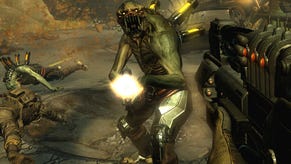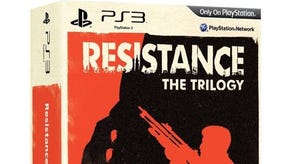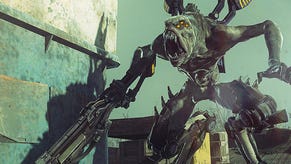Resistance: Fall of Man
And so it begins.
Poor old Insomniac. Jovial, chirpy Insomniac, who make colourful, happy games that happen to be about shooting. The friendly face of violence. They're doomed. But more on that later!
Much has been made of Resistance's decision to revise the 20th century. Simply put, where there was once a second World War, there now isn't, and where there was once rebuilding and baby-booming and all that awful roll-out-the-barrel sing-along nonsense, now there's a systematic, genocidal disfigurement of the entire Eurasian landmass by nasty half-Borg, half-Alien things with a seemingly poor record of dentistry.
It's into this vision of '50s England that you - the American, Nathan Hale, last survivor of the Yankee doodle reinforcements - are thrust, as the battle to reclaim what's left of Britain surges to a head. Off you go, Carbine in hand, stubble on chin. Jaw on floor?
Predictably your attention is drawn first to the graphics, but not necessarily in awe. There's something missing. You stumble out of a crater with your squad-mates into the jaws of the first Chimeran hybrid troops, and it all looks a bit... normal. Your comrades move with a sort of artificiality; the Chimera look rather unconvincing as they trot through the rubble-strewn Yorkshire streets firing in waves. There's a lot going on, and a lot of detail. Planes crash into the tops of buildings and paper flutters through the air as mortars strike the ground and wipe out your squad. But for all its Call of Duty style intensity, there's not a lot of... Ah.
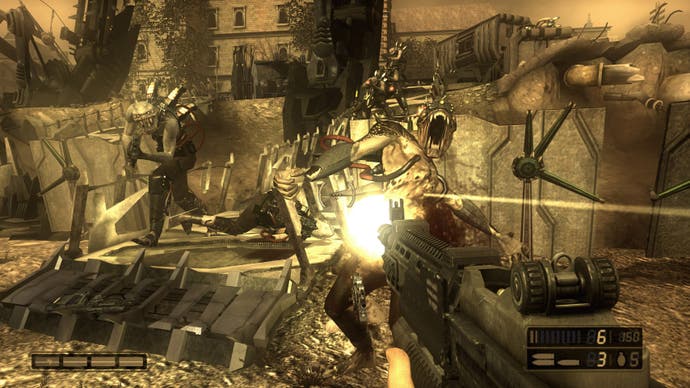
Normal mapping, specular lighting effects - the ubiquity of polishing elements such as these, to which games like Gears of War, Doom III and Halo have become so beholden, is significantly reduced. There are occasional attempts - a shiny floor here, a sparkling trouser there - and things become shinier the more overrun the world becomes with alien architecture, but the expected saturation polish is jarringly unapparent, to the game's initial detriment. It's the biggest difference between this and some of Xbox 360's recent heavyweights.
Certain effects are uniquely impressive - like when you wander down a corridor and come under fire, unable to locate the source, only to realise that the windows lining the walls are now fracturing and dismantling themselves under the weight of projectiles blasting out of rooms on either side. It's one of the nicest shatter effects I've seen. But elsewhere things are barely menial - as though the piles of rubble have been tipped out of the Emotion Engine into the PlayStation 3's frame buffer. There's quantity, but individual elements are underwhelming.
The complexity of a scene is often massive, with a huge number of battles raging, projectiles being precisely measured and frame rates never dipping below 30. There are occasions when it achieves the spectacular - peering down into the heart of a Chimeran conversion centre, fighting giant walking tanks next to London Bridge - and calls to mind the best the genre's had to offer. But these are all-too-rare eruptions of intensity in a game that struggles to be overwhelming and oppressive like Gears, or harshly believable like Ghost Recon either.
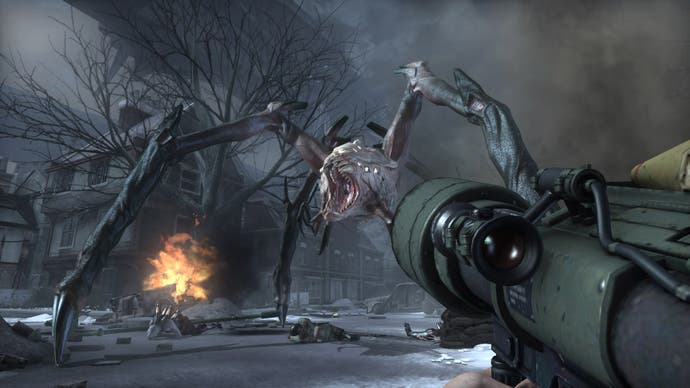
It feels patchy. The problem isn't so much that it's bland visually, it's that it feels like a series of levels that you need to empty of enemies rather than a complete environment - as though it's keen to slow down every now and then, but unsure what to offer while you catch your breath. In-game cut sequences and misty stills, over which Hale's story is narrated as a series of recollections, work hard to generate intrigue and coherency - and to some extent succeed - but they can't breathe atmosphere into the world itself.
Its narrative thrust - the Half-Life 2 style mystery of a ruined world - meets the heaviest resistance in the whole game. England doesn't feel like it's been absorbed and processed and deformed like the inside of a Giger construct; it doesn't feel like it's been seized and subjugated like the heart of City 17; there's no focal point on the horizon, just endless hordes of oddball aliens and disparate locations. It feels more like a cross between the weird world of an early Pixar film and the wacky world of an alien cartoon, skipping violently through the sets of Saving Private Ryan. Insomniac's vision is caught somewhere in the twilight between brutal realism and brutal caricature.
There are very few shocks and pangs of fright. The best examples are the rarest - when an enemy leaps for your face and you have to shake the pad to break loose. But elsewhere, a new enemy may dart across your path and out of sight as a prelude to its introduction, but the visuals and audio don't unite to foster any sense of peril, and certainly not in the way they have in the games Resistance seeks to emulate. And 'emulate' is a key term - there are spider-like stabs at headcrab, wolfish takes on Quake's fiends, tanks derived from Striders, and some of the Chimeran architecture is distinctly, er, Covetous - but the unifying characteristic, certainly in your enemies' case, is that they're all quirky-looking approximations. The spectre of the developer's origins in cartoon shoot-'em-ups haunts the aesthetic in a way the Chimera rarely haunt you.
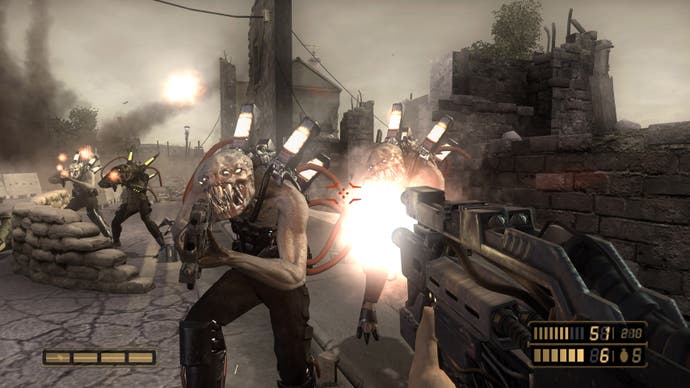
And yet for all this negativity Resistance has been billed as fairly easy game to enjoy - because Insomniac has weapons on its hands that few developers besides perhaps Valve ever manage to wield with as much expertise. The guns are meant to be the main attraction. Spread almost equidistantly across the dozen-or-so-hour medium-difficulty campaign, and easily switched between using a clever R2 inventory system, the best ones are hugely entertaining and versatile enough to drive you past anything that doesn't muster excitement. There are virtually no puzzles in Resistance; the puzzle is how to win using the ammunition available to you, and it's a puzzle you're generally compelled to solve.
Enemy AI is largely straightforward - side-stepping, ducking, a bit of movement when they realise you're running scared - but the Chimera are still difficult to overcome because they're steadily suppressant, pinning you and your fragile health bar down until you can find the right tool. Swarmed by single-hit headcrab types, you'll come to call upon the shotgun, popping them like balloons. Swamped by plasma-like balls of health-sapping fire, you'll use the Bullseye to duck out of cover and fire a tag into the main offenders, allowing you to launch your tag-seeking staccato response around corners. Flanked by hybrids, you'll toss a hedgehog grenade into their path, watching it fall in their midst, and rise up and fire darts in every direction to dismantle the threat, as you duck behind cover.


